2009 RoboCup Nanosoccer Demonstration Competition

July 2-4, 2009
Graz, Austria
Welcome to Nanosoccer!
The U.S. Department of Commerce's National Institute of Standards and Technology (NIST) is serving up "soccer under glass"—the glass of a microscope lens, that is—as nanosoccer makes its second appearance at the RoboCup games during the international competition held in Graz, Austria, from June 29-July 5, 2009.
Nanosoccer is a Lilliputian event where computer-driven "nanobots" the size of dust mites challenge one another on fields no bigger than a grain of rice. Viewed under a microscope, the nanobots are operated by remote control and move in response to changing magnetic fields or electrical signals transmitted across the microsized arena. "Nanoscale" refers to their mass. The bots are a few tens of micrometers to a few hundred micrometers long, but their masses can be just a few nanograms. They are manufactured from materials such as aluminum, nickel, gold, silicon and chromium.
The Nanogram 2009 demonstration consists of two qualifier events and one competition event: the two-millimeter dash in which nanobots seek fast times for a goal-to-goal sprint across the playing field; a slalom course where the path between goals is blocked by "defenders" (polymer posts); and a ball handling "shootout" exercise that requires robots to move "nanoballs" (spheres with the diameter of a human hair) into the goal. Unlike the initial Nanogram demonstration at the 2007 RoboCup in Atlanta, performance in the qualifier events will determine which robots compete in the shootout.
Competing in Graz will be teams from the following academic institutions: ETH Zurich (Zurich, Switzerland) and the U.S. Naval Academy (Annapolis, Md., USA). Teams working toward future nanosoccer events but unable to participate in Nanogram 2009 include Carnegie Mellon University (Pittsburgh, Pa., USA), the University of Waterloo (Waterloo, Ontario, Canada) and the Universite' de Sherbrooke (Quebec, Canada).
Nanosoccer contests "road test" agility, maneuverability, response to computer control and the ability to move objects—all skills that future industrial nanobots will need for tasks such as microsurgery within the human body or the manufacture of tiny components for microscopic electronic devices.
NIST organized the Nanogram 2009 events with the RoboCup Federation, an international organization dedicated to fostering innovations and advances in artificial intelligence and intelligent robotics by using the game of soccer as a testing ground. NIST's goal in coordinating nanosoccer competitions between the world's smallest robots is to show the feasibility and accessibility of technologies for fabricating MicroElectroMechanical Systems (MEMS), tiny mechanical devices built onto semiconductor chips and measured in micrometers (millionth of a meter). The contests also drive innovation in this new field of robotics by inspiring young scientists and engineers to become involved.
Nanosoccer Contestants
MAGMITE "THE TWINJET"
Operator: ETH Zurich (Zurich, Switzerland)
Length: ≈ 300 micrometers
Mass: ≈ 25 nanograms
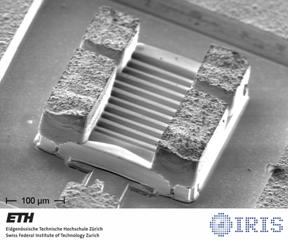
Constructed from nickel and gold, the ETH Zurich nanobot has an actuator (a mechanism that causes a device to be turned on or off, adjusted or moved) that responds to changing magnetic fields to maneuver. The robot can be driven in forward and reverse, turn left and right, and move on surfaces other than the microchip field of play.
USNA
Operator: U.S. Naval Academy (Annapolis, Md., USA)
Length: ≈ 300 micrometers
Mass: ≈ 21 nanograms
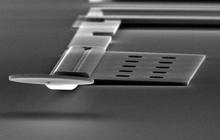
Machined from silicon and chromium, the USNA nanobot moves forward in response to an electrical waveform sent across the field of play. Turns are negotiated by touching the stylus (the wing-like tip in the foreground of the photo) to the surface of the microchip.
Teams Not Competing at RoboCup 2009 but Planning to Participate in Future Nanosoccer Events:
- Carnegie Mellon University (Pittsburgh, Pa., USA)
- Johns Hopkins University (Baltimore, Md., USA)
- University of Waterloo (Waterloo, Ontario, Canada)
- Universite' de Sherbrooke (Quebec, Canada)
Nanosoccer Field of Play
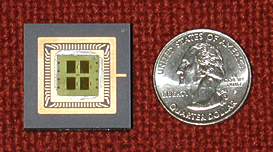
In nanosoccer, play takes place atop a 3 centimeter by 3 centimeter glass microchip—actually on just 1/16th of the chip! The chip has 4 square grids—each 1/16th of the chip's surface area—that are 2.5 millimeters on a side (about the size of a grain of rice). Each grid contains a nanosoccer field, 2 millimeters (approximately the diameter of the head of a pin) across with a 1000 micrometers long by 500 micrometers wide goal on either side.
The boundary lines of the field are marked with a thick layer of photoresist (a film applied to the microchip) that creates a wall that the nanobots cannot cross.
The field of play is provided by the contest organizers. The field of play is rectangular and has the following dimensions:
- Length Between Goal Lines: 2000 micrometers
- Depth of Goal: 500 micrometers
- Width of Field: 2000 micrometers
- Width of Boundary Lines: 25 micrometers
- Width of Goal: 1000 micrometers
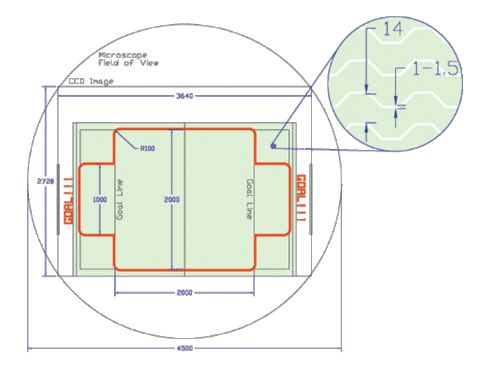
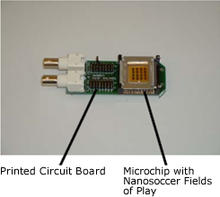
The field of play is connected to a printed circuit board (PCB) containing the control electronics. The entire unit (4 microchip fields and PCB) is placed inside the "world's smallest soccer stadium" (see diagram below for details), a miniature glove box that protects the microchip/PCB unit from humidity.
To follow the action on the nanosoccer field of play, the "stadium" is placed under an optical microscope with a 4 millimeter field of view. Both of the ocular ports (eyepieces) on the scope have cameras attached; one to record and display the competition, and the other to provide visual feedback to the nanobot operators.
World's Smallest Soccer Stadium
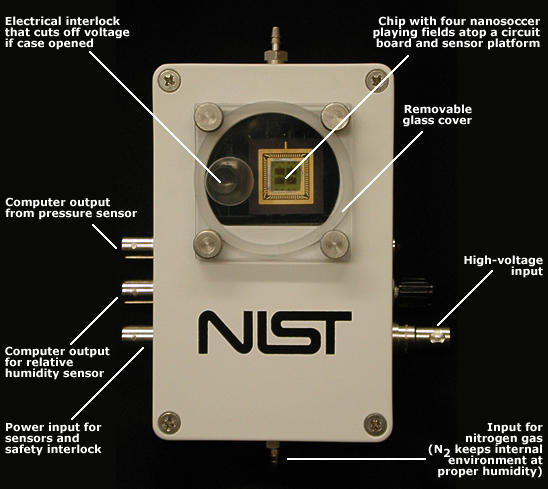
Photomicrograph of Nanosoccer Field
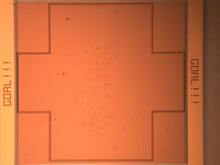
The distance between goals, 2000 micrometers, is 100 times smaller than a dust mite.
How Small is a Nanobot?
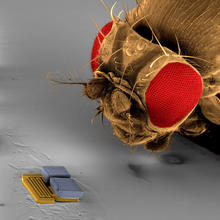
A nanobot (≈ 300 micrometers) next to a fruit fly's head (≈ 750 micrometers).
Photomicrograph of Field of Play with Defenders in Place
The nanobots must navigate around the stationary defenders to go from goal to goal.
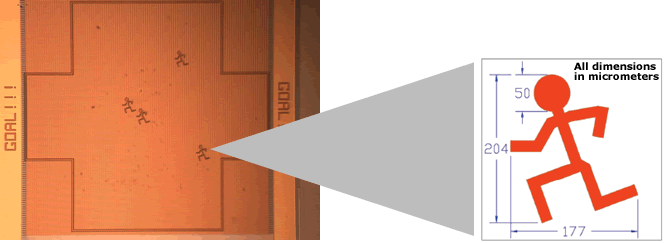
Nanosoccer Ball
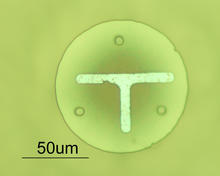
This is a silicon dioxide disk (top view) about the diameter of a human hair (100 micrometers) that can be pushed across the Nanogram Soccer field of play by the nanosoccer robots.
The "T" is a mark for spotting the ball on the field. The three circles are the location of the raised dimples on the underside of the disk that allow movement across the field.
Nanosoccer Contests
The 2009 RoboCup Nanogram competition will consist of two qualifier events and one competition event:
- First Qualifier Event — The 2-Millimeter Dash
- Second Qualifier Event — The Obstacle Course (also known as The Slalom Drill)
- Competition Event — The Ball Handling Drill (also known as The Shootout)
The graphic below shows the three events:

The 2-Millimeter Dash
Each nanobot must sprint across the playing field from one goal to the other. The robot must begin with its entire structure behind the goal line, and it completes the dash when the first point on its structure crosses the opposite goal line.
The nanobot's finish time for a trial is measured from the start signal of the referee to the completion signal of the nanobot. The maximum finish time is 2 minutes.
The nanobot's score for the event will be the quadratic mean of its finish times on each of the three trials. Lower scores beat higher scores. Any trial that results in a foul will receive a score of 3 minutes.
The Obstacle Course (also known as The Slalom Drill)
The path between the goals is blocked by "defenders" (polymer posts shaped like soccer players) that a nanobot must avoid as it races between the goals.
The nanobot's finish time for a trial is measured from the start signal of the referee to the completion signal of the nanobot. The maximum finish time is 2 minutes.
The microrobot's modified finish time for a trial is its finish time divided by the number of obstacles on the field. If the trial was disqualified, the modified finish time is 2 minutes.
The nanobot's score for the event will be the quadratic mean of its modified finish times on each of the three trials. Lower scores beat higher scores. Any trial that results in a foul will receive a score of 3 minutes.
The Ball Handling Drill (also known as The Shootout)
The nanobot must "dribble" as many "nanoballs" (silicon dioxide disks) as possible into the goal within a 3-minute period while avoiding the same type of defenders used in the Obstacle Course.
Prior to beginning the trial, the team must choose the number of balls available on the field. The number of obstacles on the field will equal the number of balls.
The nanobot's trial score is the number of balls that are entirely within the opposing goal at the end of the trial.
The nanobot's score for the event will be the quadratic mean of its trial scores. Higher scores beat lower scores. Any trial that results in a foul will receive a score of 0.
Competition Rules
All teams automatically qualify for the 2-Millimeter Dash. A team must qualify for the Obstacle Course and the Ball Handling Drill by demonstrating good performance in the earlier events.
A team will automatically qualify for the Obstacle Course upon completion of at least two out of three trials of the 2-Millimeter Dash in 2 minutes or less.
To automatically qualify for the Ball Handling Drill, a team must complete at least two out of three trials of the Obstacle Course in 2 minutes or less. Otherwise qualification will be based on relative time: no fewer than four teams will qualify for the Obstacle Course; no fewer than three teams will qualify for the Ball Handling Drill.
The events will be held in the following order:
- The 2-Millimeter Dash
- The Obstacle Course
- The Ball Handling Drill
All teams will perform all three trials of an earlier event before any team begins any subsequent event. An earlier team will perform all three trials of an event before a subsequent team begins any trial of that event.
For the 2-Millimeter Dash, the order of teams will be determined by lot.
For the Obstacle Course, teams will choose where they will fall in the order of teams. Teams with superior 2-Millimeter Dash scores will choose before teams with inferior scores. Tie scores will be broken by lot.
For the Ball Handling Drill, teams will choose where they fall in the order of teams. Teams with superior Obstacle Course scores will choose before teams with inferior scores. Tie scores will be broken by lot.

